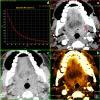Imaging biomarkers in upper gastrointestinal cancers
- PMID: 33178936
- PMCID: PMC7592483
- DOI: 10.1259/bjro.20190001
Imaging biomarkers in upper gastrointestinal cancers
Abstract
In parallel with the increasingly widespread availability of high performance imaging platforms and recent progresses in pathobiological characterisation and treatment of gastrointestinal malignancies, imaging biomarkers have become a major research topic due to their potential to provide additional quantitative information to conventional imaging modalities that can improve accuracy at staging and follow-up, predict outcome, and guide treatment planning in an individualised manner. The aim of this review is to briefly examine the status of current knowledge about imaging biomarkers in the field of upper gastrointestinal cancers, highlighting their potential applications and future perspectives in patient management from diagnosis onwards.
© 2019 The Authors. Published by the British Institute of Radiology.
Figures



References
-
- FDA-NIH Biomarker Working Group Best (biomarkers, endpoints. and other Tools) Resource 2018;Available from. - PubMed
-
- Deigner H. P, Kohl M. Precision medicine: tools and quantitative approaches. London, UK: The British Institute of Radiology.; 2018. .
Publication types
LinkOut - more resources
Full Text Sources

